Ask Ethan: How far is the edge of the Universe from the farthest galaxy?
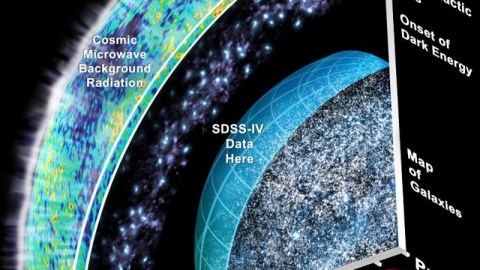
Even with the greatest telescopes imaginable, there are billions of light years with nothing recognizable by today’s standards.
“Despite its name, the big bang theory is not really a theory of a bang at all. It is really only a theory of the aftermath of a bang.” –Alan Guth
When we look out into the Universe, there’s light everywhere we can see, for as far as our telescopes are capable of looking. But at some point, there’s a limit to what we’ll encounter. One limit is set by the cosmic structure that forms in the Universe: we can only see the stars, galaxies, etc., as long as they emit light. Without that ingredient, our telescopes can’t detect anything. But another limit, if we can use astronomy to go beyond starlight, is the limit of how much of the Universe is accessible to us since the Big Bang. These two values might not have much to do with one another, and that’s what Oleg Pestovsky wants to know!
Why is the redshift of CMB … around 1,000, while the highest redshift for any galaxy we have observed is 11?
The first thing we need to think about is exactly what happens in our Universe, moving forward, from the moment of the Big Bang.
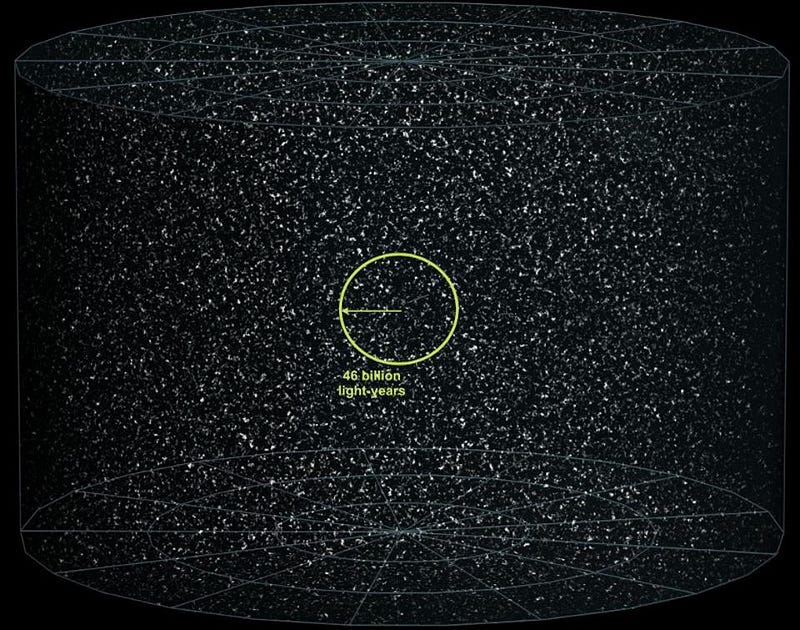
The full suite of all we know, see, observe and interact with is what we’ll call the “Observable Universe.” Beyond what we can see, there’s very likely more Universe out there, and as time goes on, we’ll be able to see more and more of it, as light from more distant objects finally reaches us after a cosmic journey taking billions of years. Seeing what we do in the Universe (and not more, and not less) is possible because of a combination of three things:
- The fact that it’s been a finite amount of time, 13.8 billion years, since the Big Bang,
- The fact that the speed of light, the maximum speed that any signal or particle can travel in the Universe, is finite and constant,
- And the fact that the fabric of space itself has been stretching and expanding ever since the Big Bang occurred.
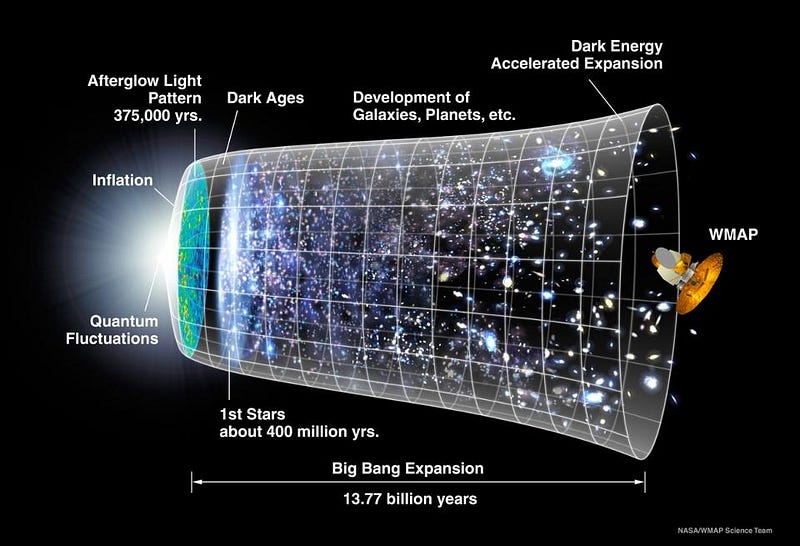
What we see today is the result of those three conditions, combined with the initial distribution of matter and energy, operating under the laws of physics for the entire history of our Universe. If we want to know what the Universe was like at any earlier time, all we need to do is observe what the Universe is like today, measure all the relevant parameters, and calculate what it was like in the past. There’s a lot we have to observe and measure to get there, but Einstein’s equations, difficult though they are, are at least straightforward. (The derived results are two equations known as the Friedmann equations, and solving them is a task every graduate student in cosmology becomes intimately familiar with.) And, quite honestly, we’ve made some incredible measurements about the Universe.
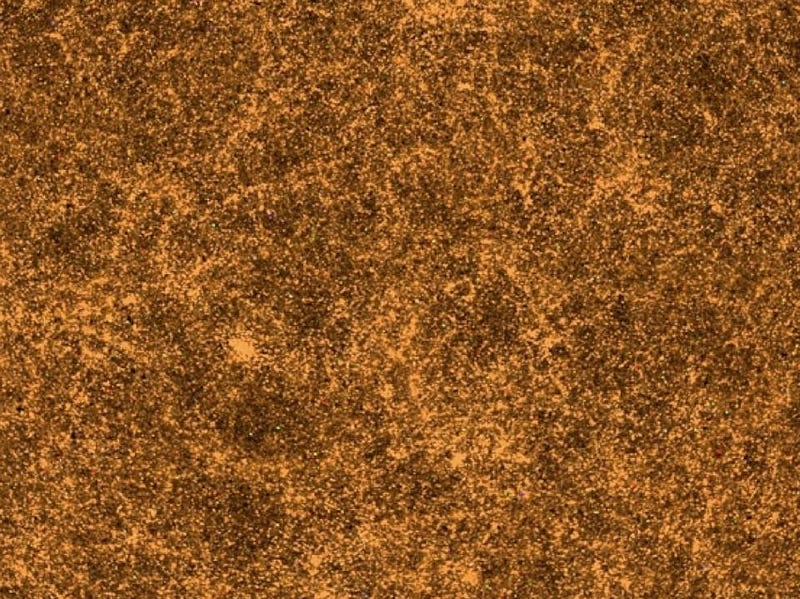
We know how fast it’s expanding today. We know what the matter density is everywhere we look. We know how much structure forms on all different scales, from globular clusters to dwarf galaxies to larger galaxies to groups and clusters and large-scale filaments. We know how much of the Universe is normal matter, dark matter, dark energy, as well as much smaller components like neutrinos, radiation and even black holes. And just from that information, extrapolating backwards in time, we can decipher both how big the Universe was and how fast it was expanding at any point in its cosmic history.
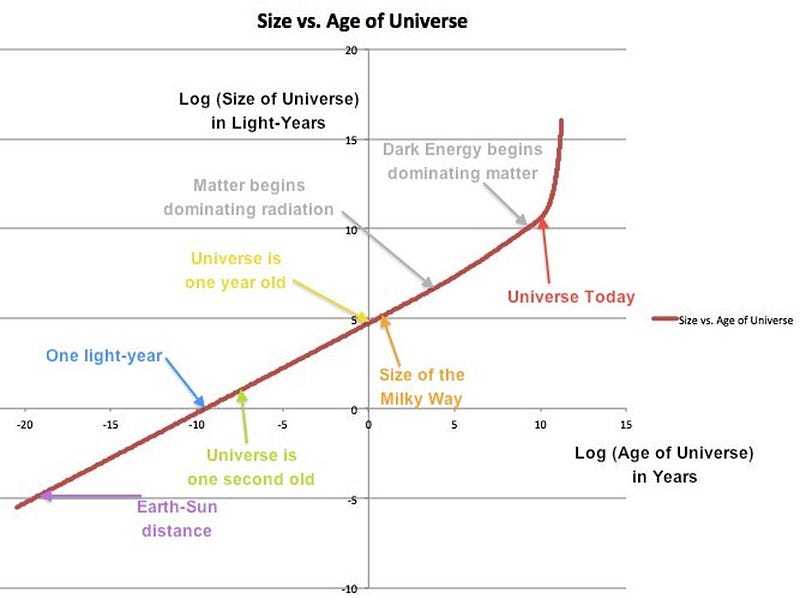
Today, our observable Universe extends for approximately 46.1 billion light years in all directions from where we are. That’s the distance that if, at the instant of the Big Bang, the original location-in-space of an imaginary particle traveling at the speed of light would be at today if it were to reach us right now, 13.8 billion years later. In principle, that’s where any gravitational waves left over from cosmic inflation — the state prior to the Big Bang that set it up and provided its initial conditions — would originate from.
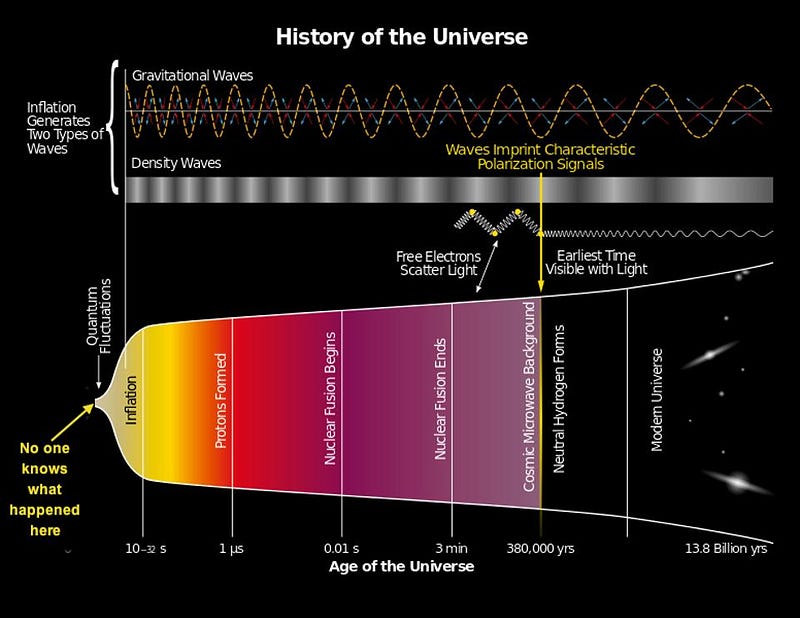
But there are other signals left over from the Universe as well. When the Universe was about 380,000 years old, the leftover radiation from the Big Bang stopped scattering off of free, charged particles as they formed neutral atoms. These photons, once neutral atoms form, continue to redshift with the expanding Universe, and can be seen with a microwave or radio telescope/antenna today. But because of how rapidly the Universe expanded back in the earliest stages, the “surface” we see this leftover glow at — the cosmic microwave background — is already only 45.2 billion light years away. The distance from the beginning of the Universe to where the Universe is at 380,000 years of age is already 900 million light years!
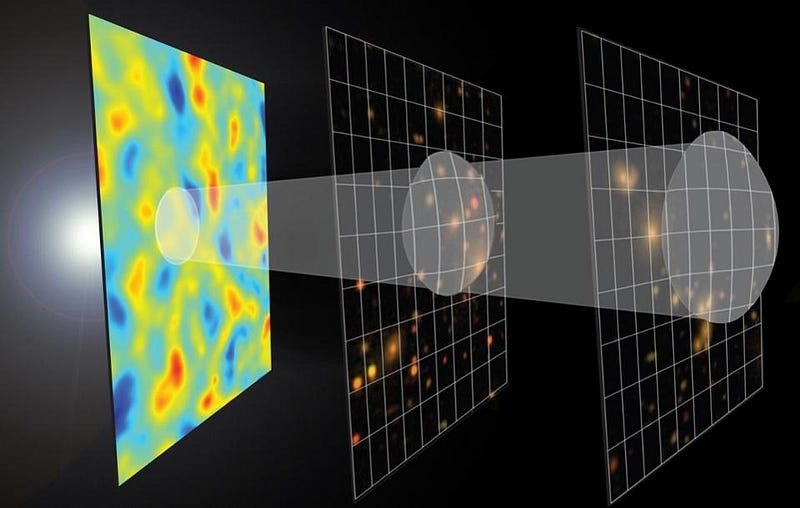
It’s much, much longer than that until we find the most distant galaxy ever discovered in the Universe. While simulations and calculations indicate that the very first stars may have formed when the Universe was between 50 and 100 million years old, and the very first galaxies at around 200 million years, we haven’t been able to see back that far just yet. (Although, hopefully, with the James Webb Space Telescope launching next year, we soon will!) The current cosmic record-holder, shown below, is a galaxy from when the Universe was 400 million years old: just 3% of its present age. However, that galaxy, GN-z11, is only located 32 billion light years away: some 14 billion light years from the “edge” of the observable Universe.
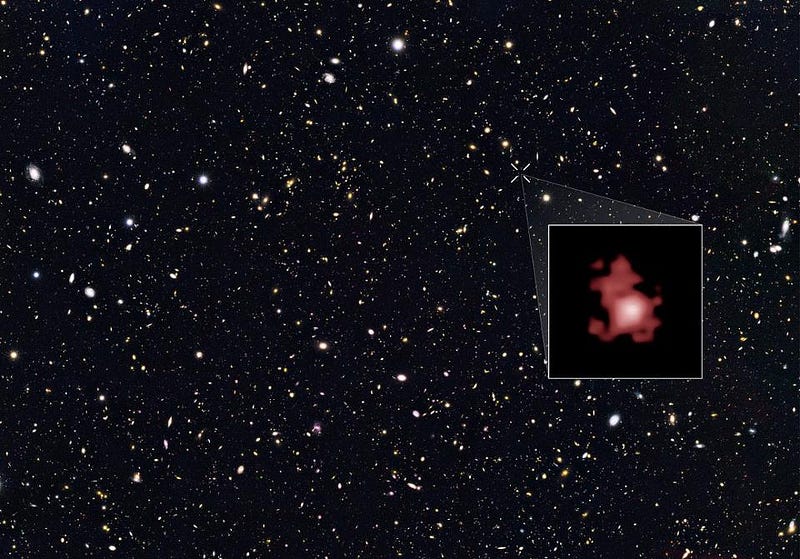
The reason for this? The expansion rate has been dropping in a tremendous fashion over time. At the time galaxy GN-z11 existed in the state we see it, the Universe was expanding 20 times faster than it is today. When the cosmic microwave background was emitted, the Universe was expanding 20,000 times faster than it is today. And at the moment of the Big Bang, to the best of our knowledge, the Universe was expanding some 10³⁶ times faster, or 1,000,000,000,000,000,000,000,000,000,000,000,000 times faster than it is today. The Universe’s expansion rate has been slowing down tremendously over time.
This is incredibly good for us! The balance between the initial expansion rate and the total amount of energy in the Universe in all its forms is perfectly balanced, to the limits of the quality of our observations. If the Universe had even slightly too much matter or radiation in the early stages, it would have recollapsed billions of years ago, and we wouldn’t exist. If the Universe had slightly too little matter or radiation early on, it would have expanded too quickly for particles to find one another and even form atoms, much less complex structures like galaxies, stars, planets and humans. The cosmic story that the Universe tells to us is one of extraordinary balance, and one where we actually get to exist.
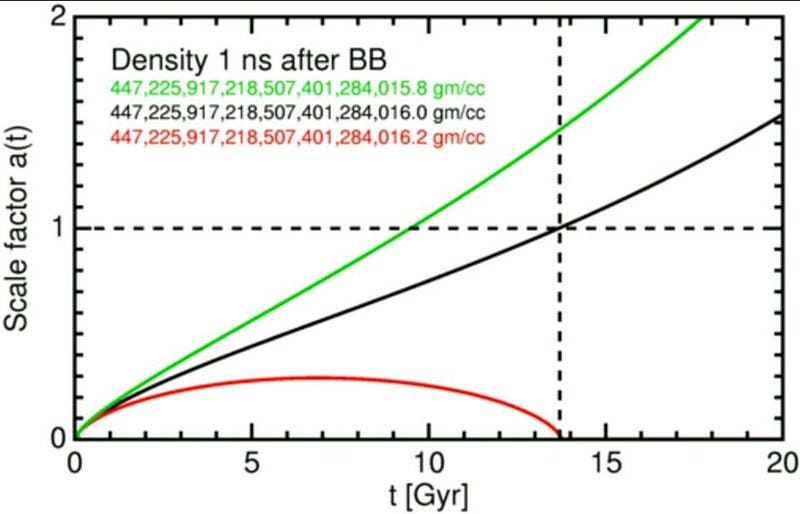
If our current best theories are correct, the first true galaxies will have formed at some point between around 120 and 210 million years of age. That corresponds to a distance from us of between 37 and 35 billion light years, placing the distance from the farthest galaxy of all to the edge of the observable Universe at 9-to-11 billion light years today. That’s incredibly far, and points to one incredible fact: the Universe was expanding extremely rapidly in the early stages, and expands at a much slower rate today. That first 1% of the Universe’s age is responsible for approximately 20% of the Universe’s total expansion!
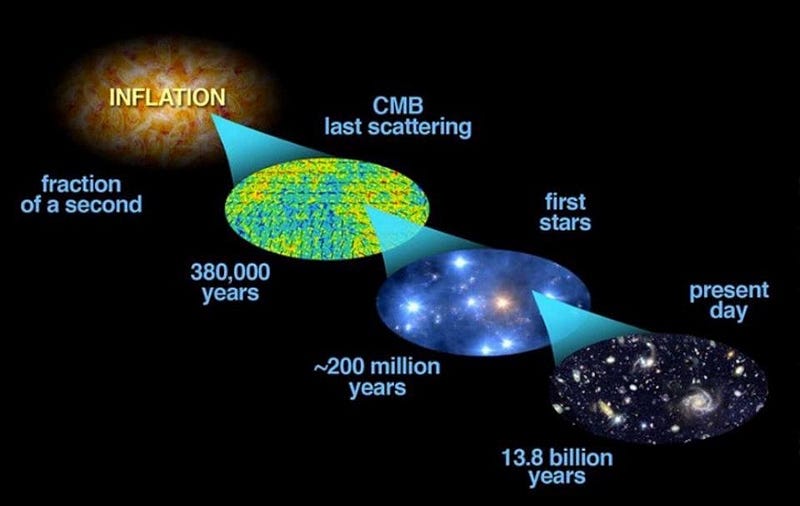
The expansion of the Universe is what’s stretched the light’s wavelength (and caused the “redshift” we see), and that rapid expansion is why there’s such a difference between the cosmic microwave background and the farthest galaxy. But the size of the Universe today is evidence of something else incredible: the incredible effects that the progression of time has. As time goes on, the Universe will continue to expand farther and farther, and by time it’s around ten times its current age, distances will have expanded so much that no galaxies beyond our local group will be visible, even with the equivalent of the Hubble Space Telescope. Enjoy all we can see today about the great variety of what’s present on all cosmic scales. It won’t be around forever!
Submit your Ask Ethan questions to startswithabang at gmail dot com!
Ethan Siegel is the author of Beyond the Galaxy and Treknology. You can pre-order his third book, currently in development: the Encyclopaedia Cosmologica.




